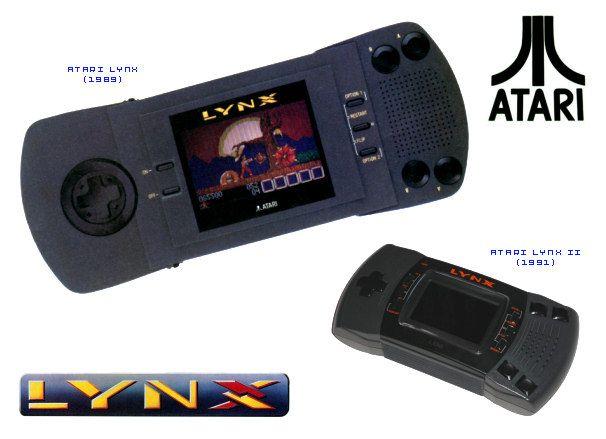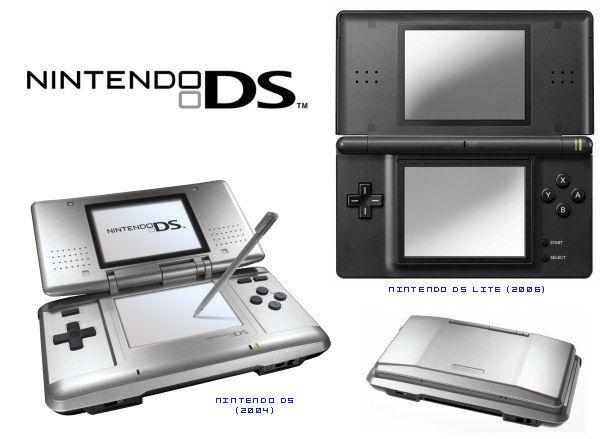-
Atari Lynx (1989) Like the Game Boy, the Atari Lynx turned 20 this year. The world's first handheld game console equipped with a color LCD display, it originated as the Handy Boy--an engineering project at game developer Epyx--before Atari acquired and released it in 1989. Though the Lynx never fared well in the marketplace, Atari in 1991 released a smaller, lighter version, the Lynx II.
-
Nintendo DS (2004) To follow up the multimillion-selling Game Boy Advance, Nintendo introduced a device with two screens, one of them touch-sensitive. Many skeptics predicted that the extra screen would prove superfluous and that the new device, the Nintendo DS, would flop. But Nintendo has had the last laugh, moving 113.48 million Nintendo DS units worldwide to date. Nintendo replaced its original, bulky DS model with the svelte and compact DS Lite in 2006, and it remains a major breadwinner for Nintendo.
-
Sega Genesis Nomad (1995) Sega released the bulky, battery-hungry Nomad at a bad time in the company's history. It had already oversaturated the market with eight incompatible platforms: Genesis, Sega CD, 32X, 32X CD, Game Gear, Pico, Saturn, and (in some markets) Master System. As a result, few consumers paid attention to the Nomad launch, and the system sold poorly. Still, the Nomad was novel in that it could play regular Sega Genesis cartridges.
-
Nokia N-Gage (2003) and Tiger Telematics Gizmondo (2005) These two unfortunate (but unrelated) consoles have one thing in common: They were impressive flops. The N-Gage combined a cell phone and a handheld video game console in a single device that performed neither function very well. The Gizmondo was an utter train wreck, complete with a terrible game library and an embarrassing marketing effort.
-
Tiger Game.com (1997) In 1997, Tiger Electronics was a well-established force in handheld LCD game devices, so it made sense for the company to compete with the Nintendo Game Boy juggernaut. The challenger it sent into the fray was the Game.com, the first handheld game console to feature a touchscreen and Internet connectivity. The device's extremely primitive Internet features fell flat, though, and almost all of the Game.com's games were terrible. It received a bargain-bin redesign under the name "Pocket Pro" a year later, and soon sold for no more than $30 before quietly dropping off the map.
-
Nintendo Game Boy Advance (2001) By 2000, the models in Nintendo's original Game Boy line--with their limited color capabilities--were showing their age. In 2001, Nintendo released the Game Boy Advance, a 32-bit color handheld (still lacking a backlight) that could play more-complex, more-colorful games. Like other Game Boys before it, the Advance sold very well. It received two major updates: the backlit, clamshell-style Game Boy SP in 2003; and the ultrasmall Game Boy Micro in 2005.
-
Nintendo Game Boy (1989) Nintendo launched its first portable game system, the Game Boy, 20 years ago. Thanks to the device's long battery life and to hit titles like Tetris, Nintendo has sold more than 100 million units of the original Game Boy line (not including Game Boy Advance) worldwide to date, making it the longest-running dynasty in the video game business. A few revisions (shown here) kept the line fresh over the years.
-
Thirty years ago this fall, Milton Bradley released the world's first handheld video game system with interchangeable cartridges, the Microvision. Prior to 1979, handheld electronic games were stuck with one predetermined game (or set of games) per unit. After the Nintendo Game Boy debuted a decade later, the market for cartridge-based handheld devices exploded, inspiring hardware vendors both prominent and obscure to release gadgets for playing multiple games on. In honor of the technology's pearl anniversary, let's take a look at some notable successes and notorious failures in the history of handheld gaming. This overview is by no means complete, so feel free to share your favorite (and least favorite) mobile gaming memories with us. One caveat: These game consoles are memorable, but not always in a good way. In fact, a few of them are on our list of the worst video game systems of all time.
-
SNK Neo Geo Pocket Color (1999) In 1998, SNK released its first handheld game system, the Neo Geo Pocket, in Japan only. This first console sported a monochrome screen and did not sell particularly well. A year later, SNK introduced the Neo Geo Pocket Color (NGPC) worldwide, and it became the most promising competitor to the Game Boy line in almost a decade. The NGPC fared well at first, thanks to good software, long battery life, and low cost; but ultimately it could not compete with Nintendo's superior game franchises and third-party support.
-
The current generation of handheld devices blurs the lines separating multimedia devices, pocket computers, and game devices, emphasizing wireless Internet networking and online distribution of games--notably pushed by Apple on the iPhone and the iPod Touch. Since Apple's astounding success with the App Store, both Nintendo and Sony have stepped up their online distribution efforts with their Nintendo DSi and PSP Go consoles, respectively. As we look to the future, the complete extinction of physical game media (cartridges, cards, and discs) seems imminent. Also, expect handheld game consoles to merge further with multifunction pocket devices such as smartphones as they compete for limited pocket space.
-
Sony PlayStation Portable (2004) The PlayStation brand had ruled the home console market for over a decade, so it seemed inevitable that Sony would challenge Nintendo's handheld dominance. Early in the battle of PlayStation Portable vs. Nintendo DS, many critics figured that the PSP would win handily because of its impressive graphical, multimedia, and networking capabilities. But that's not the way things have turned out: Instead, the DS has outsold the PSP by a ratio of roughly 2:1. The PSP has managed to do siginificantly better than past Nintendo competitors--mostly because the PSP and DS occupy different niches in the handheld console market. Sony has introduced three major updates to the PSP since 2004: the slimmed-down PSP-2000 in 2007, the PSP-3000 in 2008, and most recently, the PSP Go.
-
Entex Select-A-Game Machine (1981) This obscure machine walks a fine line between handheld and tabletop. Entex designed the SAG for potential two-player action on a table, but during single player matches, it was easy to hold somewhat upright. The Select-A-Game included a "vacuum fluorescent display" with display elements arranged in a 7 by 16 grid. Entex released only six game cartridges for this system, most notably versions of Pac-Man and Space Invaders. Photo Courtesy Rik Morgan (handheldmuseum.com)
-
Milton Bradley Microvision (1979) The Microvision may have been a pioneer, but its capabilities were primitive. Its 16-by-16-pixel black-and-white LCD screen made the goal of producing truly involving games difficult for software engineers. The Microvision shipped ready to play ball-and-paddle games with an analog control knob. It also contained a 12-button rubber key matrix on which the cartridge inserted into the system could configure different "buttons." Overall, the Microvision sold poorly, and for the next decade few companies imitated its modular software design.
-
NEC TurboExpress (1990) The NEC TurboExpress was the first handheld console to play game cartridges designed for use in a home video-game console, in this case, the TurboGrafx-16. The TurboExpress sold for a hefty price ($250 in 1990, the equivalent of about $413 in 2009 dollars), and it guzzled batteries like Mechagodzilla, limiting its appeal. Ultimately, it remained a capable-but-flawed rich person's toy.
-
Epoch Game Pocket Computer (1984) In some ways, the Epoch Game Pocket Computer was the spiritual precursor to the Nintendo Game Boy. This Japan-only console incorporated a nonbacklit black-and-white LCD screen (with 75 by 64 resolution), worked with small interchangeable game cartridges, and was designed for gamepad-like handheld play, with a directional pad and action buttons. It failed to take off in Japan, however, and Epoch made only five games for the system. Photo Courtesy Chris Covell
-
Sega Game Gear (1990) Based on technology used for the 8-bit Sega Master System, the Game Gear was a capable and relatively inexpensive color game machine. It outsold its competitors (the TurboExpress and the Atari Lynx) due in part to its licenses to run popular Sega games like Sonic the Hedgehog and in part to the halo effect of Sega’s wildly successful Genesis home console.
-
Game Park GP32 (2001) The GP32 from Korean company Game Park is notable for being the first handheld game console designed to allow amateurs to program and distribute software for the system with few restrictions. Games were stored on standard SmartMedia flash cards, which made moving data between the console and a computer easy. As a result, the GP32 quickly amassed a large array of applications that allowed users to play games from other (usually older) systems through emulation. Few third-party developers chose to write games for the platform, however, probably because they were concerned that the relatively open platform would encourage piracy.
-
Bandai WonderSwan Color (2000) The WonderSwan (1999), a monochrome system designed by the company headed by ex-Nintendo employee Gunpei Yokoi--the creator of the Game Boy--went head-to-head-to-head with Nintendo's handheld and the Neo Geo Pocket in Japan. Though the challenger got off to a shaky start, it gained steam with the release of the WonderSwan Color in 2000. Soon afterward, translations of several early Final Fantasy titles were released for the WonderSwan and sold very well. In 2002, it received a final update, the SwanCrystal, which sported a sharper color screen. No WonderSwan units were sold in the United States.
-
Nintendo Game Boy Color (1998) In 1998--nine years after the first Game Boy--Nintendo released a Game Boy with a color screen. The new device still lacked a backlight, however, an omission that kept its price low and its battery life long. The Game Boy Color represented a significant extension of the Game Boy platform, since it possessed slightly better technical capabilities than its predecessor while maintaining backward compatibility with the earlier Game Boy. It sold very well and extended Nintendo's dominance in the handheld market for another few years.
In Pictures: 3 decades of hand-held game systems
19 Photos
Three decades after the debut of Milton Bradley's Microvision, here's a look at how handheld video game systems evolved, from early flops like the Atari Lynx to the gaming innovations of the iPhone.



















